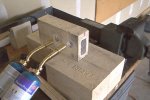Well, after a sabatical of 25 years I have returned to making knifes. Last time I made knifes I always shipped them out at a very high expense to have them treated. I cant afford that this time.
I have ground a boot knife 10" overall, 5" blade out of 7/8" x 1/8" precision ground Crucible 0-1 stock.
The forge is an idea from Wayne Goddard's "$50 knife shop" only I am using a two propane torches instead of one. I have just tested the forge on an old 10" file and was really impressed with the nice consistent and even color I was able to get.
Here is the question. The stock is already in an annealed state. Can I go directly to the hardening quench, or should I normalize, anneal, then quench?
Also, I need recomendations for little smoke, even less fire, oil.
Any help would be greatly appreciated.
Thanks
Loosenock
I have ground a boot knife 10" overall, 5" blade out of 7/8" x 1/8" precision ground Crucible 0-1 stock.
The forge is an idea from Wayne Goddard's "$50 knife shop" only I am using a two propane torches instead of one. I have just tested the forge on an old 10" file and was really impressed with the nice consistent and even color I was able to get.
Here is the question. The stock is already in an annealed state. Can I go directly to the hardening quench, or should I normalize, anneal, then quench?
Also, I need recomendations for little smoke, even less fire, oil.
Any help would be greatly appreciated.
Thanks
Loosenock

